
The Kitzbühel Alps are a mountain range of the Central Eastern Alps surrounding the town of Kitzbühel in Tyrol, Austria. Geologically they are part of the western slate zone.

The Stubai Alps is a mountain range in the Central Eastern Alps of Europe. It derives its name from the Stubaital valley to its east and is located southwest of Innsbruck, Austria. Several peaks form the border between Austria and Italy. The range is bounded by the Inn River valley to the north; the Sill River valley (Wipptal) and the Brenner Pass to the east ; the Ötztal and Timmelsjoch to the west, and to the south by tributaries of the Passer River and Eisack.

The Karwendel is the largest mountain range of the Northern Limestone Alps. The major part belongs to the Austrian federal state of Tyrol, while the adjacent area in the north is part of Bavaria, Germany. Four chains stretch from west to east; in addition, there are a number of fringe ranges and an extensive promontory (Vorkarwendel) in the north.

The Zillertal Alps are a mountain range of the Central Eastern Alps on the border of Austria and Italy.
The Bezirk Schwaz is an administrative district (Bezirk) in Tyrol, Austria. It borders Bavaria (Germany) in the north, the districts of Kufstein, Kitzbühel and Pinzgau (Salzburg) in the east, South Tyrol (Italy) in the south, and the Innsbruck-Land district in the west.

The Ziller Valley is a valley in Tyrol, Austria that is drained by the Ziller River. It is the widest valley south of the Inn Valley and lends its name to the Zillertal Alps, the strongly glaciated section of the Alps in which it lies. The Tux Alps lie to its west, while the lower grass peaks of the Kitzbühel Alps are found to the east.

Patscherkofel is a mountain and ski area in the Alps, in Tyrol in western Austria, 7 km (4 mi.) south of Innsbruck. The peak rises to a summit elevation of 2,246 m (7,369 ft) above sea level. The town of Igls at its northwest base is at 870 m (2,854 ft), a vertical drop of 1,376 m (4,514 ft).

Tux is a municipality in the Schwaz district in the Austrian state of Tyrol.

Navis is a municipality in the district Innsbruck-Land in the Austrian state of Tyrol located 19 km southeast of Innsbruck in a valley with the same name which is a side valley of the Wipptal. The extensive territory of this municipality runs from the Sill up to the 2,359 m high Klammjoch saddle and the 2,886 m high Lizumer Reckner in the Tux Alps. The village is provided with fresh drinking water thanks to the clean Navisbach. The origin of the village name is unknown but settlement began at the end of the 13th century. Copper and silver were found in the 15th and 16th century.

Schmirn is a municipality in the District Innsbruck-Land in the Austrian state of Tyrol.
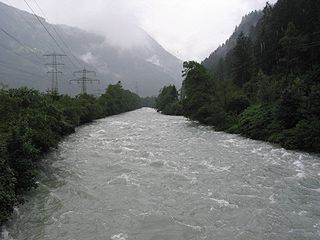
The Ziller is a right tributary to the Inn, in the Zillertal in Tyrol, Austria. It is 55.7 km (34.6 mi) long, and its basin area is 1,135 km2 (438 sq mi). It springs from the ridge of the Zillertal Alps, and feeds the Zillergründl Dam. In Mayrhofen it receives the Zemmbach (that in turn receives the Tuxbach. By Zell am Ziller it receives the Gerlosbach, before it flows into the Inn by Strass im Zillertal.

The Wetterstein mountains, colloquially called Wetterstein, is a mountain group in the Northern Limestone Alps within the Eastern Alps. It is a comparatively compact range located between Garmisch-Partenkirchen, Mittenwald, Seefeld in Tirol and Ehrwald along the border between Germany (Bavaria) and Austria (Tyrol). Zugspitze, the highest peak is at the same time the highest mountain in Germany.

The Wattentaler Lizum is the name of the head of the Wattental valley which branches off the lower Inn valley near Wattens. Lizum' means "alpine pasture at the head of the valley" in Tyrolese. The Wattentaler Lizum lies at the eastern end of the valley in the municipality of Wattenberg.

The Olperer is a 3,476-metre-high (11,404 ft) mountain in the Zillertal Alps in the Austrian federal state of Tyrol. It is the main summit on the Tux Crest and is often crossed in the summer as climbers transit from the Olperer Hut to the Geraer Hut. It was first climbed on 10 September 1867 along the southeast ridge (Südostgrat) by Paul Grohmann, Georg Samer and Gainer Jackl. On its north flank is the ski region known as Hintertux Glacier on the Gefrorene-Wand-Kees glacier.

The Tuxer Joch is a mountain pass in the Zillertal Alps at a height of 2,338 m (AA) that links the lower Zillertal valley with the Brenner route just north of the Brenner Pass. To the northeast just below the summit lies the Tuxer Joch-Haus.
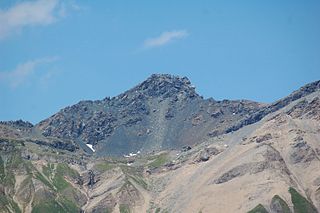
The Lizumer Reckner is, at 2,886 m above sea level (AA), the highest mountain in the Tux Alps in the Austrian state of Tyrol.
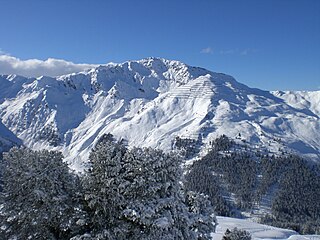
The Gilfert is a 2,506-metre-high (8,222 ft) peak in the Tux Alps. It is the most northerly extent of the Rastkogel Massif and can therefore be seen from almost anywhere in the Lower Inn Valley.
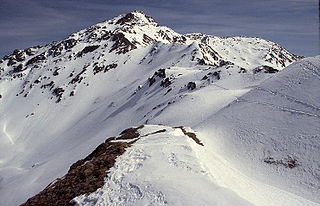
The Rastkogel is a 2,762 metre high, pyramidal, mountain on the main crest of the Tux Alps in the Austrian federal state of Tyrol.
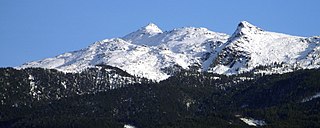
The Glungezer is a mountain in the Tux Alps in Tyrol southeast of Innsbruck in Austria.

The Rosenjoch is a mountain, 2,796 m (AA), and the highest point of the Voldertal and Arztal in the western Tux Alps. The top which bears a summit cross lies on the Inn Valley Mountain Trail between the Glungezer Hut and Lizumer Hut in the Wattentaler Lizum and is thus frequently climbed in summer. The Rosenjoch may also be reached from the Voldertal Hut.























